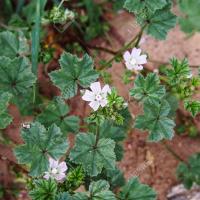Dwarf mallow
Malva neglecta
Malva neglecta, commonly known as common mallow or cheeseweed, is a herbaceous annual or biennial plant belonging to the Malvaceae family. Here's a detailed description:
Botanical Description:
-
Habit:
- Common mallow is an erect, spreading plant with a bushy growth habit.
-
Height:
- It typically grows to a height of about 30 to 60 centimeters (12 to 24 inches).
-
Leaves:
- The leaves are alternate, rounded, and palmately lobed with five to seven lobes. They are soft to the touch and have a mild scent.
-
Stems:
- The stems are round, often reddish or green, and covered with fine hairs.
-
Flowers:
- The flowers are pink or purple with darker veins, and they have five petals. They are about 2 to 3 centimeters (0.8 to 1.2 inches) in diameter.
-
Inflorescence:
- The flowers are arranged in clusters at the leaf axils.
-
Fruit:
- After flowering, the plant produces round, disc-shaped fruits with multiple segments, each containing a single seed.
Identification Tips:
-
Soft, Rounded Leaves:
- The soft, rounded leaves with palmate lobes are a distinctive feature.
-
Pink to Purple Flowers:
- Look for the pink or purple flowers with darker veins.
-
Clustered Fruits:
- The round fruits are clustered at the leaf axils.
Habitat:
-
Distribution:
- Common mallow is widespread and can be found in various regions around the world.
-
Habitat:
- It is often found in disturbed areas, lawns, gardens, and along roadsides.
Uses:
-
Edible Greens:
- The leaves of common mallow are edible and have been historically used in salads and cooked dishes.
-
Medicinal Uses:
- In some traditional medicine practices, common mallow has been used for its potential medicinal properties.
Management and Control:
-
Cultural Practices:
- Maintaining a healthy lawn or garden with thick vegetation can help suppress the growth of common mallow.
-
Manual Removal:
- Hand-pulling or hoeing can be effective for small infestations, especially when done before the plant produces seeds.
-
Herbicides:
- Selective herbicides labeled for use on broadleaf weeds may be used in areas where control is necessary. Always follow recommended application rates and guidelines.







